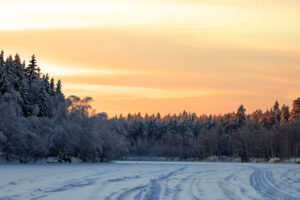I’ve been watching several local tracts for a while, because they puzzle me. Each tract is broadly similar—mostly woods, some open.
They range in size from about 100 acres to 1,700. And each is priced at between $3,000 and $4,000 per acre. A few of the larger tracts are priced at the upper end of the range, and a few of the smaller ones are priced closer to $3,000/acre.
None of the big ones, of course, have moved for several years. And the sellers have stuck with their original prices.
The common expectation for a long time among both buyers and sellers of land was that as the size of the tract increased its price-per-acre should decrease. No rule or formula seemed to exist, but small tracts were typically priced at something like five to ten times higher than large tracts on a per-acre basis. (Many exceptions exist to that generalization.)
That pattern held more or less until the last 15-20 years. It still holds in some places and on some tracts, but I’ve seen it increasingly weaken—which I think is a bad development from a market perspective.
The relationship between size and price is not consistent in commercial matters. Larger diamonds — other things being equal — command higher per-carat prices, where carat is a unit of weight that is also expressed as size (mass). In gems, big is rarer than little, so big costs more. In cattle, heavier animals, which are also larger than lighter animals, fetch a lower per-pound price for the same breed and frame quality. Large quantities of common retail products — soap, hamburger, ice cream — are almost always sold for less per ounce in the same brand than small quantities. Packaging expenses may sometimes explain the higher cost for smaller quantities, but my guess is that it’s mostly about manufacturers wanting to move as much product as possible.
Size, as distinct from weight, is also not consistent. Larger suits (for larger men) generally cost more than smaller suits, owing to more material and workmanship. Larger cars may or may not be more expensive per unit of mass. Size alone in cars is not necessarily the definition of value.
In land, large tracts are, with local exceptions, rarer than small tracts. On that dimension alone, larger tracts — like big diamonds — should carry a higher per-unit price.
On the other hand, large tracts usually package in liabilities, uncertainties and costs that small tracts usually don’t. That may explain some of the historic discount in per-acre price for larger tracts. Another historic factor, I think, has been that fewer buyers exist for large tracts, so sellers have to discount to get their large tracts sold. Larger tracts also may have been price-discounted because they are far away from high-priced metropolitan and suburban real estate. Big tracts may be price-discounted owing to the remoteness or inconvenience of their locations.
Finally, it may be that large-tract price discounting came partly out of American historical habit. Until fairly recently, American land was relatively plentiful and cheaply valued. Much of it was originally given away to speculators, Revolutionary war vets, railroads, local and state governments, homesteaders and farmers. Cheap land was the inducement to western settlement.
In recent years, sellers added some portion of the increase in per-acre prices for large tracts onto the backs of their higher-and-better-use hopes.
Some degree of the trend in per-acre price inflation, of course, may be entirely justified by local and market conditions. Two hundred acres of quality corn-growing land should be worth the same amount on a per-acre basis as 2,000, other things being equal, since a bushel of corn earns the same money per unit of production regardless of the size of its field. While I think this particular type of farmland is an ethanol-dependent bubble, I don’t see any reason why large tracts should be bubbled less than small tracts.
My concern is that some, if not many, large tracts have had their per-acre price inflated for not-very-defensible reasons, such as: 1) sellers paid too much for them in 2000-2007; 2) sellers impute HBU value where none, or not much, exists; 3) sellers are over-valuing what they own because they own it; 4) sellers are misreading the market; and 5) sellers are confusing the past with the present.
One reason that the market for large tracts of rural land is largely stuck tight in many places has to do with the resistance of sellers to sufficiently discount per-acre price in light of size. I’m certainly willing to admit that not all such properties should be steeply discounted on a per-acre basis, but I do think the market expects it.
In my small corner of the world, buyers of larger tracts are not valuing 1,500 acres at the same per-acre price as 100 acres. Maybe they’re right, or maybe they’re not. But that’s where they are.
If the market is going to move, per-acre price for big and small will have to be uncoupled.
This content may not be used or reproduced in any manner whatsoever, in part or in whole, without written permission of LANDTHINK. Use of this content without permission is a violation of federal copyright law. The articles, posts, comments, opinions and information provided by LANDTHINK are for informational and research purposes only and DOES NOT substitute or coincide with the advice of an attorney, accountant, real estate broker or any other licensed real estate professional. LANDTHINK strongly advises visitors and readers to seek their own professional guidance and advice related to buying, investing in or selling real estate.










Per unit value of real estate is determined by its marginal value (utility) to the end user. Typically as the size of real estate increases, the marginal utility to the end user decreases and the price (rent) the end user is willing to pay on the diminishing marginal utility also decreases, therefore putting downward pressure on the per unit value of real estate as the size increases.
Curtis that is a good analysis, and I often see a reluctance in buyers to pay the same per acre price for larger properties as on smaller parcels. In this economy I am seeing people look at the per acre price more closely, like someone in a supermarket comparing the price per ounces. That is a bad way to compare land if it is your main criteria. Value and not price should be a much bigger concern.
I think Sam Walton has conditioned us to think that if you buy something in bulk you deserve a discount.
Perfect summary. I have watched Buyers consistently offer premium to Sellers if they will split off larger parcels so they can get a smaller tract in their price range.
To Mr. McCullough:
If freshman economics explained the distortion between size and price, I would not have written this article.
My little part of the real world shows something different than what an econ 101 textbook predicts.
Two patterns present themselves.
One: large acreages are sometimes priced at small-acreage per-acre prices. Why is this pattern showing itself and what is the impact on the market?
Two: at the recent timberland investment summit, one of the presenters showed a price-to-size chart that found clustering at around $1500/A across the size spectrum. Why is that?
Since there have been very few really large acreages sold over the last year or so, it’s hard to determine the diminishing marginal utility in price-per-acre reduction with these properties.
I think seller psychology is keeping large-acreage prices up (and unsold. If the textbook ruled, the market would be moving.
Yrs. Curtis
Curtis –
Your specific market must be experiencing some short-term disequilibrium probably attributed to the lack of reliable market information (sales comps). You say there have been few large parcels sold over the past year. If that is the case, it would not be possible to know whether the marginal utility relationship between large parcels and small parcels has changed since you would have to compare one to the other. I suspect it has not. There’s just a deficiency in the amount/quality of market information available. You can deny the rules of Micro-Economics, but real estate is no different than any other good or service – supply and demand rule. It sounds like supply has yet to catch up with demand.
There is a strong dose of pride and bravado in the ownership of larger parcels. While there are less people that can command the buying power to buy 1,500 acres than there are 100 acres, there is some perceived value to the “big guy” in being able to wield the necessary power to possess a large property…which may explain the unwillingness to move off of price. Those people are somewhat more insulated on a personal level from the necessity to sell than people in ownership of the smaller parcels. They have holding power…those closer who are in ownership of the smaller parcel have less holding power.
This is sort of the view from 50,000 feet, and will not apply to individual properties/people nearly as well as it will to the macro-market. It may not make financial sense, but not all markets do.
When I was developing Rural Land years ago, I would purchase large tracts (in our market 110 to 300 Acres is large) for less than $2,000.00 per acre. Breaking them up into 10+ acre tracts brought $3,500 to $4,000 per acre and it made since to develop.
Beginning in 2007, larger acerage tracts were bringing $4000 to $6,000 per acre and 10+ acre tracts were averaging $6,200 per acre, therefore not enough margin to develop.
That’s where we are today with less buyers.
Curtis: Great article and timely as I just purchased 4 acres adjacent to my 36 acres of recreational timberland along the shores of Toledo Bend Lake in Northwest Louisiana/East Texas. As one responder put it, there is “bravado” in having more acres and I am getting more mileage in attracting interest in 40 acres than in the 36. Buyers with deeper pockets are interested in having a “forty” on the lake. I think that comes from the old farm days when people talked of the upper and lower forties and it was carried over as a minimum for local hunting camps as well. I don’t think diminishing marginal utility has much to do with most buyers of the larger tracts, but it does for those who just want some rural acreage and a little privacy–and that would be most rural buyers. Always enjoy reading your articles, Curtis. Keep ’em comin’!
Kurt
Curtis, a good article
In my neck of the woods I think that 1031 exchange purchase (during 2003 to 2007) was a significant factor for the drive up in the sale prices of large land tracts. Since 2008 1031 money has dried up and large land tracts are not selling at the previous prices (seller psychology seller reluctance to sell for less than previous prices)
Jerry
Good job as usual, Curtis!
Here in NH it’s getting harder to find large tracts, especially those with views, convenient to the more desirable towns and good recreation. I’d want to add that certain factors, such as whether or not a tract has easy electric service access, if it’s on a class 6 road and such can have an impact on the per acre amount a parcel will command. I think when pulling comps it warrants searching a wider area to find the sales of few larger tracts sold…..
Regards,
Richard 🙂
Investor, 13% interest on your capital, TAX FREE.
I’ve been looking for land in East Tennessee and I keep running into the problem of high prices per acre because the sellers themselves paid too much for the land.
People are trying to get back the over priced amount they paid, plus a profit.
I’m finding the same thing in looking for a home.
Sellers are refusing to come down on their prices because they don’t want to lose money as a result of their initial purchase price being unrealistic.
Same with commercial property. My husband I want to open a coffee house but the commercial property in our area is over priced. There are so many empty buildings around here, and no one can afford the prices. I suppose it’s a tax write off for the owners and that’s why they won’t come down on price.
$300,000 per acre for a commercial spot!
Perhaps I am just ignorant of the value of an acre.
I won’t buy at that price because then if I ever wanted to resell, I would never make my money back, much less make a profit.
Kudzu, with patience, you will find a seller who bought before the bubble and didn’t play cash-out mortgage roulette. That seller will likely find fair market value pretty quickly. And commercial property value can easily be determined through prevailing rents – it’s not really a guessing game, but simple arithmetic. Good luck in your search.
I have both bought and sold parcels of around 100 acres in Southern TN lately, and have found that most buyers in the 100 acre size are families looking for a private homestead, but near enough to their job to commute. The problems with sales I have seen are that regular folks with good jobs can’t get loans for undeveloped rural land because of the combination of low appraisals and the general difficulty in getting a loan for rural land at a reasonable interest rate, long term, and low down-payment. The few available lenders will only loan 75% of the appraised values, and they must be drawing their comps from foreclosure auctions, and not conventional sales. I can point to adjacent parcels that sold in the $3K-4.6K per acre range but the appraisals won’t exceed $2.5K per acre. I have found many willing buyers who can comfortably make the payments at the “asking price”, but don’t have the patience to save up the cash to make the down payment required to satisfy the lenders. So the “credit crunch” is a very real impediment to the buyers I encounter. This is not a case of buyers trying to qualify for more land than they can afford to make the payments on, but the lenders just making it impossible for regular folks to qualify due to onerous down payment requirements. Owner financing is an option that is often employed to close the deal, when possible.
I really appreciate seeing this article and reading the comments posted by readers. The phenomenon you describe is one that has always intrigued me. When I first started getting researching and buying rural land, I was shocked that larger acreages went for lower prices per acre than smaller acreages. That seemed like a great deal to me, because I would ten times prefer having a larger property than a smaller one and I even get a discount! In my world of investment banking, when we sell a company, it goes for a higher price per dollar of earnings the larger it is (for a variety of reasons). I can think of a number of other markets where this is also the case. Though I understand all of the reasons cited above for why this condition persists in the land market, it seems counterintuitive to me that it should be this way. Prices, at some point, as illustrated by Lou, must be bound by the ability of market participants to engage in arbitrage. After all, if large properties went for a sufficiently high discount, you could immediately turn around and carve them up and sell them for higher prices per acre profiting with little to no effort or intelligence. If you could make a lot of money doing this, allowing for the expenses of surveying and legal work, everyone would do it, so it makes a lot of sense to me to hear that these opportunities are becoming rare. On the other hand, one cannot easily assemble large contiguous tracts of land from multiple small tracts owned by many different individuals (though that is what I am trying to do). Therefore, larger tracts will inevitably become more and more rare. I don’t want to predict the future, as the trend could stay as it is for some time or forever, but I would not be surprised if at some point over the long term the situation reversed itself and larger properties actually went for a premium to small properties as they became exceedingly rare and people were looking for large properties to have to themselves. I get the argument that smaller properties go for higher prices because there are more buyers out there for them, but I don’t think that this cursory explanation really addresses the issue. After all, yes, there are more buyers for these properties, but there are a lot more of these properties on the market too, so I would argue that a more relevant theoretical metric to consider would be the ratio of buyers to available properties, which is probably not as different between the small and large acreage markets. This is a view from someone who doesn’t do this everyday, which I think might be a good thing. I know this is contrary to what a lot of you feel should be the case. I would love to see some agricultural professor somewhere conduct a nationwide study into this issue to help explain the the key drivers in detail.